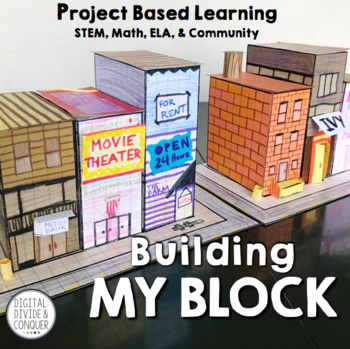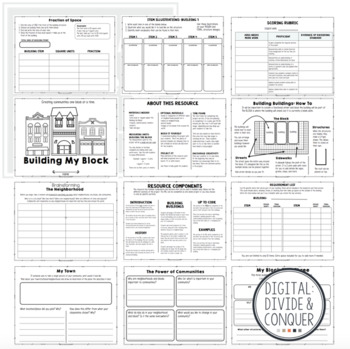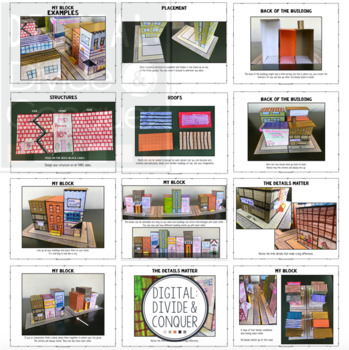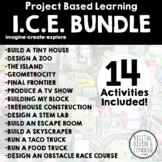Build A City Block PBL - Project Based Learning for STEM, ELA, & Community
- Zip
What educators are saying
Also included in
- This bundle includes fourteen project based learning activities that focus on a variety of cross-curricular skills These PBL’s focus on a variety of cross-curricular skills and still take your students on adventures that they will never forget, even though they'll still be in the classroom. ThesePrice $74.95Original Price $92.00Save $17.05
Description
There's not a better way to understand the power and importance of a community than taking part in creating one yourself. Towns and cities around the world are filled with incredibly diverse neighborhood blocks --so why don't we let the students design their own? By incorporating geometry, writing, and organizational design skills students can do just that, build their own city block.
***THIS RESOURCE IS NOW DIGITAL for DISTANCE LEARNING***
See below for more details on using it with Google Slides.
Building My Block is a project based learning activity that asks students to design their own block and build it. This STEM-infused PBL combines cross-curricular concepts and allows students to create a city block that is completely their own.
This project based learning activity focuses on pushing students to create and design while using math, writing, and design skills while applying problem solving techniques and collaborating with others. It allows for easy differentiation, so students can work at a pace they will be successful at. There are steps and procedures to assist students through this project, but the work and results will be determined by their ideas that each students adds.
There are five sections of this PBL (and when connected) allow for students to apply multitude of skills and concepts into a project that connects with the world around them. Teachers have the options (and total control) of choosing which section of the resource they would like to complete. Teachers can mix and match all sections to fit needs of their classrooms. This PBL does not have to use all sections to be completed.
The project is broken into five sections:
Introduction
In this portion of the project students will work to learn and understand how neighborhoods and communities around the world function and differ, based on where they are located. The students discuss their own communities and why they are important using this time to collaborate and discuss many different elements that make neighborhoods and communities unique.
History
In this portion of the PBL, students will choose buildings they would like for their blocks. Plus, they’ll create the history of the buildings they are creating. This will include how old the buildings are, what they represent, and even people that live in them. This section focuses on creative writing with a written history and creating the history of the community/building.
Building Buildings:
Students will design a 3D model of their BLOCK. Their BLOCK will include at least three structures/buildings such as apartments, shops, banks, or other structures that are part of a community.
Students create blueprints for three different structures first as rough drafts, then as a larger and final version. The blueprints will connect to the final portion of the project...building their block.
Up To Code:
This section of the PBL will be completed at the end when they look back at their structures and pull out math concepts from their buildings. There are portions that look at identifying vocabulary, applying geometry skills, understanding area/perimeter, and recognizing how critical math skills are in designing and building.
This portions includes a heavy emphasis on geometry skills and understanding area and perimeter.
Examples:
Included are over ten pages of examples for creating the 3D versions of the city blocks. These examples start with the structures, roofs, and block.
INCLUDED IN THIS RESOURCE:
9 About this Resource & Instructions
13 Building My Block, cover page
14 SECTION ONE: INTRODUCTION
15 Brain Storm: Students brainstorm what they know about neighborhoods and blocks in cities and towns.
16 Structures:
Students categorize different types of building structures found around towns.
17 Vocabulary:
Students write or illustrate the definition for 24 vocabulary words related to towns/cities.
19 Power of Communities:
Students answer open-ended questions about communities.
21 My Town:
Students write about their own town; including what it’s like and what makes it unique.
23 SECTION TWO: HISTORY
24 Pick Three:
Students choose three buildings that they will create for their city block.
26 Creating a History: Students develop a backstory for each building (year built, owners, current business, etc).
29 Written History: Students write a narrative story using (or adding to) information they shared on the previous page.
31 SECTION THREE: BUILDING BUILDINGS
32 Info and How-To:
This includes four pages of directions for Building Buildings with examples and illustrations.
36 Requirements List:
Students must list 10 items to be included for each building they design.
There are three pages of this Requirements List. (They all look the same, but are for each of the three individual buildings.)
39 Item Illustrations:
Students design single elements of the building and will list math terms they can identify within their sketches. There are two pages for each building.
45 Rough Draft:
Students create a rough draft for all three of the buildings they are creating.
46 Final Version:
Students design their final (larger) version of each building.
49 The Block:
Students design the block (this is the base) for the buildings to stand on.
50 Additional Sizes:
There are three additional sized STRUCTURES included. These have the SAME base, length, and width--but the height varies. Students may use these in place (or in addition) to their block.
-The varying height size will give the block a different look and style. Students may use them to stack on top of existing buildings or whatever else they can think of.
54 Roofs:
This single page of five roofs can be used for any additional structures students create.
55 SECTION FOUR: UP TO CODE
57 Area and Perimeter:
Students must find the area and perimeter of items they list on their Requirements List for each building.
60 Geometric Design:
Students identify math terms on their buildings.
This can be changed to identifying geometric/math terms on other students’ blocks if the teacher chooses.
61 Fraction Of Space:
Students find the area on the front of the buildings then create fractions for the amount of space that item takes up.
62 SECTION FIVE: EXTENSION and EXAMPLES
63 Interior Design:
Students can create the interior of the buildings or base of their block.
64 3D Items:
Students will want to add the little details to their city. This shows them how to add smaller three dimensional items using graphing paper.
68 Rubrics and Reflection:
Students can complete their own reflection of the project. Teachers have two options for rubrics, a single point scale and the more traditional 5 point scale.
72 Examples:
Included are examples of a variety of buildings and blocks. These can be projected on white boards for students to visualize what their city blocks will look like.
Materials Needed
-paper
-card stock or regular paper (for
Building the Block)
-crayons, colored pencil, markers
-scissors
-tape and glue
Measuring Units:
Building the block
The measurement used for this project will be a single unit per cube.
-You may choose to increase complexity by making each cube worth more. Use this with students to easily differentiate.
-Example: 1 square = 3 units or 1 square = 5 units
-There are no feet, yards, or meters.
Time Frame
The time frame for completing this project will vary. If you are planning on completing it in a week, give 45-60 minutes per day--but it still could take longer, depending one how deep you want students to take this.
Time can vary based on many factors. One area that may take longer is when student design and build the block. Once students understand how it works and is put together, they may try to take it to another level (which is encouraged).
***THIS RESOURCE IS NOW DIGITAL!***
ACCESSING THIS DIGITAL RESOURCE
There are two pdf files included in the zip file. To access the digital file for Google Slide open the file with the title "digital" in it. Then click the hyperlink included on the first page (inside the yellow box) to access the file online.
What you need to get started:
1. Download Link for the Google Slide Product
2. Have access to the Internet and a Google Account. (FREE)
3. Open the file on your own Google Drive and engage while in the edit mode.
4. Printer access to print out the finished product. (OPTIONAL).
Beginning your Google Slides Project:
Before you begin editing/filling in your project, it is VERY important to first make a copy of the file, on your own Google Drive.
Once you make a copy of the original file it will enable you to make some changes. This includes deleting pages, order, adding more text boxes/shapes.
After creating a copy of the resource you can decide which slides you would like to include and which ones to delete before you assign this as an assignment.
*********
See More Projects in my custom category:
MORE LIKE THIS:
ZOO DESIGN: Area, Perimeter, Map Skills, Project Based Learning, & More!
THE ISLAND: Project Based Learning for Writing, Math, Reading, Science, & SS
GEOMETROCITY: Create & Build a City Made of Math Using Geometry
FINAL FRONTIER, 3 part project: ELA, Math, Science
BUILD A TINY HOUSE: Project Based Learning Activity with Geometry, Area, and Perimeter
DESIGN AN OBSTACLE RACE COURSE with Area and Perimeter
RUN A TACO TRUCK: Decimals, Area, Perimeter, Geometry, and Guacamole
PRODUCE A TV SHOW: Development, Script Writing, and Build a TV Set
BUILDING MY BLOCK: Your Neighborhood PBL for Math and ELA
TREEHOUSE CONSTRUCTION: Design Your Dream House In the Trees, A PBL
Project Based Learning 10-PACK BUNDLE
Project Based Learning, Build a Ski Resort
Project Based Learning, Design a School Library
Project Based Learning, Design a Water Park
Project Based Learning, Discovery In the Rainforest
Project Based Learning, Earth Day Invention
Project Based Learning, Running A Lemonade Stand
Project Based Learning, Save Christmas
Project Based Learning, Shark Security Force
Project Based Learning, Snake Search: Around the World
Project Based Learning, Valentine’s Day Party Planner
Project Based Learning 10-PACK BUNDLE, PART 2
Project Based Learning Activity: Plan a School Party
Project Based Learning Activity: All About Bats
Project Based Learning Activity: Arctic Adventure
Project Based Learning Activity: Plan a Field Day
Project Based Learning Activity: President For A Week
Project Based Learning Activity: Run A Toy Drive
Project Based Learning Activity: Plan Thanksgiving Dinner
Project Based Learning Activity: Let's Go Camping
Project Based Learning Activity: Monster Squad
Project Based Learning Activity: Island Survival
Project Based Learning 10-PACK BUNDLE, PART 3
Project Based Learning Activity: Create A Classroom Community
Project Based Learning Activity: Design A Video Game
Project Based Learning Activity: Alive In The Desert
Project Based Learning Activity: Endangered Animal Awareness
Project Based Learning Activity: Habitats Around The World
Project Based Learning Activity: Design A Miniature Golf Course
Project Based Learning Activity: Run A Music Festival
Project Based Learning Activity: The Ultimate Playground
Project Based Learning Activity: Design A Theme Park
Project Based Learning Activity: Water World, Save the Earth
Project Based Learning 10-PACK BUNDLE, PART 4
Project Based Learning Activity: Insect Infestation
Project Based Learning Activity: Into the Wilderness
Project Based Learning Activity: The Animal Shelter
Project Based Learning Activity: Making Your Mindset
Project Based Learning Activity: Cardboard Creation
Project Based Learning Activity: Bears Everywhere
Project Based Learning Activity: Design An Arcade
Project Based Learning Activity: Create A Summer Camp
Project Based Learning Activity: Plan A Vacation
Project Based Learning Activity: Design A Treehouse
GRAB A BUNDLE:
Project Based Learning 10-PACK BUNDLE
Project Based Learning 10-PACK BUNDLE, PART 2






